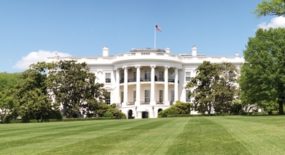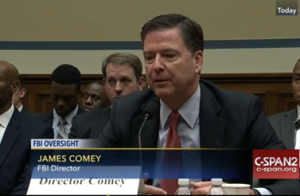Module 7 Bureaucracy and the Federal Courts
In this chapter:
Overview of Module 7
Classroom Lessons and Activities
Class Exercise: Women and the Courts
Additional Resources
Overview
Module 7 for the seventh week of the course includes the following page giving an overview of the Module’s content and the week’s activities:
Module 7 (Week 7) Overview – The Bureaucracy & The Courts
[NOTE: As we take a closer look this week at the Executive and Judicial branches of the US government, keep in mind your Research Project and ask yourself what role these parts of government have played in the issue affecting your marginalized group. Also, what role could they play in helping to resolve the issue? If you can identify a role for them, you may want to consider adding that to the Recommendation section of your Research Report.]

Photo credit: https://www.whitehousehistory.org/filters/gardens-grounds
The Executive branch – “part 2”
As you read Chapter 14, The Bureaucracy, keep in mind that we are still looking at the Executive Branch of the federal government as we did in Chapter 13, The Presidency. The “federal bureaucracy” refers to the mass of agencies and employees who work for the President in executing the laws passed by Congress and fulfilling other duties as directed by the President or his appointees.
A growing bureaucracy. The federal bureaucracy has grown in size substantially since 1787 (only 3 agencies originally!), primarily in response to citizens’ demands for more services from their government and elected officials’ desires to expand the role of government (often motivated by their own desire for more power and influence). Also note that the federal bureaucracy is run by a combination of political appointees (appointed by the President) and career civil servants. Appointees are typically appointed for political reasons to do the President’s bidding, but the civil servants are career employees who are hired under a competitive merit system and who can generally be removed from their jobs only for serious misconduct.

Photo credit: screen capture, c-span.org.
Some agencies/employees deal with the pandemic. As we watched the Covid-19 pandemic unfold, we saw the role of civil servants like Dr. Anthony Fauci, whose jobs are to provide their expertise to government decision-makers in an impartial, non-partisan manner. Political appointees, like Alex Azar, Secretary of Health & Human Services (under President Trump), however, serve “at the pleasure of the President” and can be removed at any time (and were) by the President for any reason (or no reason).

Photo credit: screen capture, c-span.org.
President Trump and the FBI. Early in his term, Trump fired FBI Director James Comey, who was continuing to pursue an investigation into the Trump campaign’s Russia connections. Comey was a political appointee (appointed by President Obama) and therefore not protected by civil service laws, but most of the FBI agents who worked for Comey are protected. (Those in the FBI whom President Trump believed were disloyal to him he labeled “The Deep State”, an alleged, but unproven, conspiracy theory that career officials who run the government were working to undermine President Trump’s political agenda.) Think about how well (or not) this interplay between political appointees and career officials has worked in the government’s handling of the Covid-19 crisis — making sure Americans are safe, that states have what they need to fight the pandemic, etc.
Photo credit: https://www.supremecourt.gov/about/photos.aspx
Chapter 15, The Courts, is our first in-depth look at the third branch of the federal government, the Judicial Branch, created by Article III of the Constitution. The Constitution is mostly silent about the role of the federal Judiciary in the checks and balances of government, so the role the federal courts play now has evolved primarily by decisions of the Supreme Court itself. In other words, the Court has largely defined its own Constitutional role. The Framers paid scant attention to the role of the judiciary because they assumed that most court cases would be handled by the courts of each state. But in the landmark case of Marbury vs. Madison in 1803, Supreme Court Chief Justice John Marshall decided that “judicial review” was an implicit role for the federal judiciary, deciding cases in which the issue of whether a law passed by Congress, or an action by the Executive Branch, conflicted with the Constitution. Ever since, the federal courts have played an increasing role in shaping the contours of our American political system, from deciding that a President cannot refuse legitimate requests from Congress (U.S. v. Nixon), declaring that racially segregated public schools are unconstitutional (Brown v. Board of Education), and to overturning their own 50 year-old decision in Roe v. Wade, giving back to the states exclusive authority to determine the issue of abortion within their own state (Dobbs v. Jackson Health).
More recently, the Supreme Court reversed lower federal court rulings that had allowed the state of Wisconsin to conduct its primary election by altered voting procedures designed to avoid putting voters at risk during the pandemic (Republican National Committee v. Democratic National Committee). And as you know from last week’s assignment, the Court refused in 2019 to allow federal courts to review whether partisan gerrymandering cases were unconstitutional (Rucho v. Common Cause).
Photo credit: Supreme Court Justices. https://www.supremecourt.gov/about/justices.aspx
No better evidence of the importance of the Court’s political role is the fact that Senator Mitch McConnell, when he was Republican Senate Majority Leader during Trump’s presidency, made Senate confirmation of President Trump’s nominees to federal court vacancies his highest priority. Judges are supposed to be non-political in their decision-making (which is why they are appointed for life and can be removed only for serious misconduct) – and all will say they are – but the political influence in who gets appointed, and why, is undeniable. Trump set a record in his 4-year term, getting Senate confirmation of 234 federal judges. So far in Biden’s presidency, the Senate has confirmed 105 federal judges (abcnews.com, Feb 17, 2023). Why are the appointment of federal judges so important to presidents and their parties?

